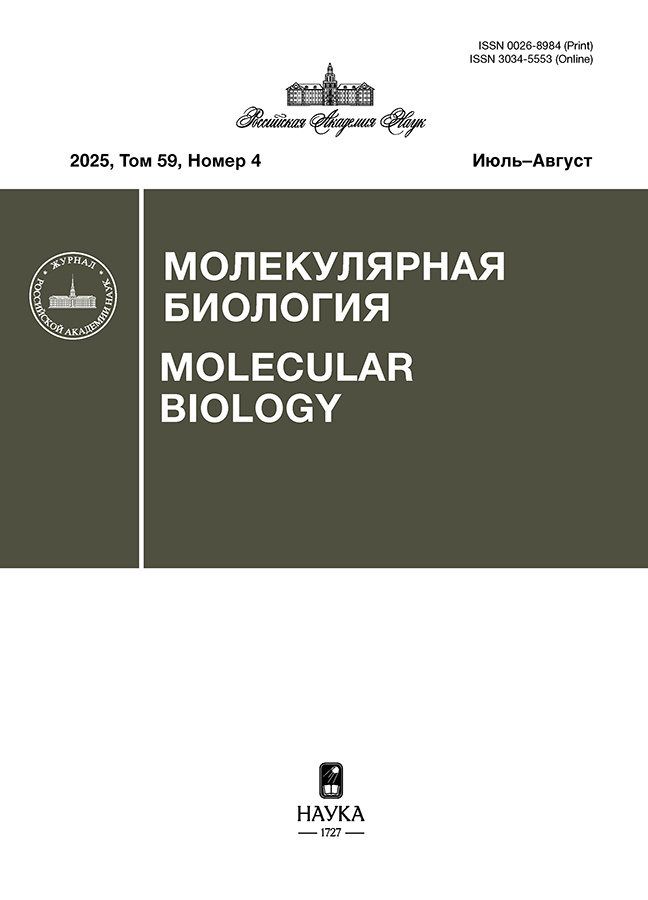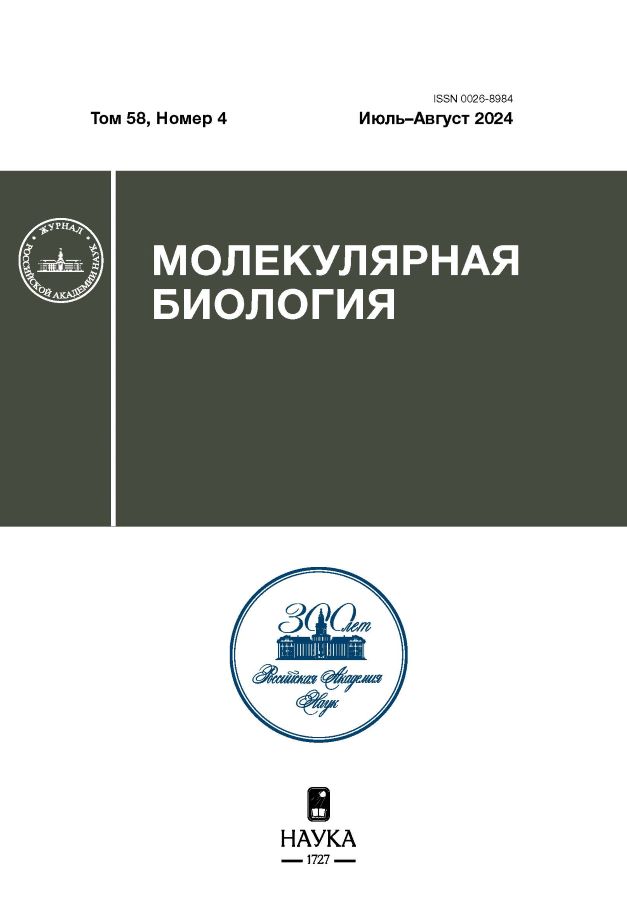Регуляция трансляции фактора eRF1 человека
- Авторы: Шувалов А.В.1,2, Клишин А.А.1,3, Бизяев Н.С.1, Шувалова Е.Ю.1,2, Алкалаева Е.З.1,2,3
-
Учреждения:
- Институт молекулярной биологии им. В. А. Энгельгардта Российской академии наук
- Центр высокоточного редактирования и генетических технологий для биомедицины
- Московский физико-технический институт (национальный исследовательский университет)
- Выпуск: Том 58, № 4 (2024)
- Страницы: 627–637
- Раздел: МОЛЕКУЛЯРНАЯ БИОЛОГИЯ КЛЕТКИ
- URL: https://innoscience.ru/0026-8984/article/view/655308
- DOI: https://doi.org/10.31857/S0026898424040091
- EDN: https://elibrary.ru/IMNJKL
- ID: 655308
Цитировать
Полный текст
Аннотация
Фактор терминации трансляции эукариот eRF1 – важный клеточный белок, играющий ключевую роль в процессах терминации трансляции, нонсенс-опосредованного распада мРНК (NMD) и сквозного прочтения стоп-кодонов. Количество eRF1 в клетке влияет на все эти процессы. Механизм регуляции трансляции eRF1 через авторегуляторный NMD-зависимый контур экспрессии описан у растений и грибов, тогда как механизмы регуляции трансляции eRF1 человека до сих пор не изучены. С помощью репортерных конструкций нами изучено влияние элементов мРНК eRF1 на его трансляцию в бесклеточных системах трансляции и культуре клеток HEK293. Наши данные указывают на отсутствие NMD-зависимого авторегуляторного контура экспрессии eRF1 человека. Обнаружено, что на трансляцию основной рамки считывания eRF1 сильнее всего влияют 5'-нетранслируемая область мРНК этого фактора и старт-кодон короткой открытой рамки считывания. Согласно базе данных стартов транскрипции, для мРНК eRF1 характерна высокая гетерогенность начала транскрипции и варьирующая из-за этого длина 5'-нетранслируемой области. Кроме того, старт-кодон основной рамки считывания в мРНК eRF1 находится в пределах известного регулятора трансляции короткой 5'-нетранслируемой области (TISU), который также стимулирует транскрипцию мРНК генов с высокой гетерогенностью старта транскрипции. Мы предполагаем, что регуляция синтеза eRF1 человека осуществляется как на уровне транскрипции, так и на уровне трансляции. На уровне транскрипции регулируется длина 5'-нетранслируемой области eRF1 и количество коротких открытых рамок считывания в ней, регулирующих, в свою очередь, продукцию eRF1 на уровне трансляции.
Полный текст
Об авторах
А. В. Шувалов
Институт молекулярной биологии им. В. А. Энгельгардта Российской академии наук; Центр высокоточного редактирования и генетических технологий для биомедицины
Автор, ответственный за переписку.
Email: alkalaeva@eimb.ru
Россия, Москва, 119991; Москва, 119991
А. А. Клишин
Институт молекулярной биологии им. В. А. Энгельгардта Российской академии наук; Московский физико-технический институт (национальный исследовательский университет)
Email: alkalaeva@eimb.ru
Россия, Москва, 119991; Московская обл., Долгопрудный, 141700
Н. С. Бизяев
Институт молекулярной биологии им. В. А. Энгельгардта Российской академии наук
Email: alkalaeva@eimb.ru
Россия, Москва, 119991
Е. Ю. Шувалова
Институт молекулярной биологии им. В. А. Энгельгардта Российской академии наук; Центр высокоточного редактирования и генетических технологий для биомедицины
Email: alkalaeva@eimb.ru
Россия, Москва, 119991; Москва, 119991
Е. З. Алкалаева
Институт молекулярной биологии им. В. А. Энгельгардта Российской академии наук; Центр высокоточного редактирования и генетических технологий для биомедицины; Московский физико-технический институт (национальный исследовательский университет)
Email: alkalaeva@eimb.ru
Россия, Москва, 119991; Москва, 119991; Долгопрудный, Московская обл., 141700
Список литературы
- Bertram G., Bell H.A., Ritchie D.W., Fullerton G., Stansfield I. (2000) Terminating eukaryote translation: domain 1 of release factor eRF1 functions in stop codon recognition. RNA. 6, 1236–1247.
- Frolova L., Seit-Nebi A., Kisselev L. (2002) Highly conserved NIKS tetrapeptide is functionally essential in eukaryotic translation termination factor eRF1. RNA. 8, 129–136.
- Bulygin K.N., Khairulina Y.S., Kolosov P.M., Ven'yaminova A.G., Graifer D.M., Vorobjev Y.N., Frolova L.Y., Kisselev L.L., Karpova G.G. (2010) Three distinct peptides from the N domain of translation termination factor eRF1 surround stop codon in the ribosome. RNA. 16, 1902–1914.
- Bulygin K.N., Khairulina Y.S., Kolosov P.M., Ven'yaminova A.G., Graifer D.M., Vorobjev Y.N., Frolova L.Y., Karpova G.G. (2011) Adenine and guanine recognition of stop codon is mediated by different N domain conformations of translation termination factor eRF1. Nucl. Acids Res. 39, 7134–7146.
- Kryuchkova P., Grishin A., Eliseev B., Karyagina A., Frolova L., Alkalaeva E. (2013) Two-step model of stop codon recognition by eukaryotic release factor eRF1. Nucl. Acids Res. 41, 4573–4586.
- Brown A., Shao S., Murray J., Hegde R.S., Ramakrishnan V. (2015) Structural basis for stop codon recognition in eukaryotes. Nature. 524, 493–496.
- Frolova L.Y., Tsivkovskii R.Y., Sivolobova G.F., Oparina N.Y., Serpinsky O.I., Blinov V.M., Tatkov S.I., Kisselev L.L. (1999) Mutations in the highly conserved GGQ motif of class 1 polypeptide release factors abolish ability of human eRF1 to trigger peptidyl-tRNA hydrolysis. RNA. 5, 1014–1020.
- Zhouravleva G., Frolova L., Le Goff X., Le Guellec R., Inge-Vechtomov S., Kisselev L., Philippe M. (1995) Termination of translation in eukaryotes is governed by two interacting polypeptide chain release factors, eRF1 and eRF3. EMBO J. 14, 4065–4072.
- Frolova L., Le Goff X., Zhouravleva G., Davydova E., Philippe M., Kisselev L. (1996) Eukaryotic polypeptide chain release factor eRF3 is an eRF1- and ribosome-dependent guanosine triphosphatase. RNA. 2, 334–341.
- Stansfield I., Jones K.M., Kushnirov V.V., Dagkesamanskayal A.R., Poznyakovski A., Paushkin S.V., Nierras C.R., Cox B.S., Ter-Avanesyan M.D., Tuite M.F. (1995) The products of the SUP45 (eRF1) and SUP35 genes interact to mediate translation termination in Saccharomyces cerevisiae. EMBO J. 14, 4365–4373.
- Paushkin S.V., Kushnirov V.V., Smirnov V.N., Ter-Avanesyan M.D. (1997) Interaction between yeast Sup45p (eRF1) and Sup35p (eRF3) polypeptide chain release factors: implications for prion-dependent regulation. Mol. Cell. Biol. 17, 2798–2805.
- Ito K., Ebihara K., Nakamura Y. (1998) The stretch of C-terminal acidic amino acids of translational release factor eRF1 is a primary binding site for eRF3 of fission yeast. RNA. 4, S1355838298971874.
- Merkulova T.I., Frolova L.Y., Lazar M., Camonis J., Kisselev L.L. (1999) C-terminal domains of human translation termination factors eRF1 and eRF3 mediate their in vivo interaction. FEBS Lett. 443, 41–47.
- Namy O., Hatin I., Rousset J. (2001) Impact of the six nucleotides downstream of the stop codon on translation termination. EMBO Rep. 2, 787–793.
- Atkins J.F., Loughran G., Bhatt P.R., Firth A.E., Baranov P.V. (2016) Ribosomal frameshifting and transcriptional slippage: from genetic steganography and cryptography to adventitious use. Nucl. Acids Res. 44, 7007–7078
- Rodnina M.V., Korniy N., Klimova M., Karki P., Peng B. Z., Senyushkina T., Belardinelli R., Maracci C., Wohlgemuth I., Samatova E., Peske F. (2020) Translational recoding: canonical translation mechanisms reinterpreted. Nucl. Acids Res. 48, 1056–1067.
- Brogna S., Wen J. (2009) Nonsense-mediated mRNA decay (NMD) mechanisms. Nat. Struct. Mol. Biol.16, 107–113.
- Шабельская С.В., Журавлева Г.А. (2010) Мутации в гене SUP35 нарушают процесс деградации мРНК, содержащих преждевременные стоп-кодоны. Молекуляр. биология. 44, 51–59.
- Schweingruber C., Rufener S.C., Zünd D., Yamashita A., Mühlemann O. (2013) Nonsense-mediated mRNA decay – Mechanisms of substrate mRNA recognition and degradation in mammalian cells. Biochim. Biophys. Acta (BBA) – Gene Regulatory Mechanisms. 1829, 612–623.
- Karousis E.D., Gurzeler L.-A., Annibaldis G., Dreos R., Mühlemann O. (2020) Human NMD ensues independently of stable ribosome stalling. Nat. Commun. 11, 4134.
- Yang Q., Yu C.-H., Zhao F., Dang Y., Wu C., Xie P., Sachs M.S., Liu Y. (2019) eRF1 mediates codon usage effects on mRNA translation efficiency through premature termination at rare codons. Nucl. Acids Res. 47, 9243–9258.
- Wada M., Ito K. (2019) Misdecoding of rare CGA codon by translation termination factors, eRF1/eRF3, suggests novel class of ribosome rescue pathway in S. cerevisiae. FEBS J. 286, 788–802.
- Dever T.E., Ivanov I.P., Sachs M.S. (2020) Conserved upstream open reading frame nascent peptides that control translation. Annu. Rev. Genet. 54, 237–264.
- Bidou L., Allamand V., Rousset J.-P., Namy O. (2012) Sense from nonsense: therapies for premature stop codon diseases. Trends Mol. Med. 18, 679–688.
- Janzen D.M. (2004) The effect of eukaryotic release factor depletion on translation termination in human cell lines. Nucl. Acids Res. 32, 4491–4502.
- Freitag J., Ast J., Bölker M. (2012) Cryptic peroxisomal targeting via alternative splicing and stop codon read-through in fungi. Nature. 485, 522–525.
- Schueren F., Lingner T., George R., Hofhuis J., Dickel C., Gärtner J., Thoms S. (2014) Peroxisomal lactate dehydrogenase is generated by translational readthrough in mammals. ELife. 3, e03640
- Hofhuis J., Schueren F., Nötzel C., Lingner T., Gärtner J., Jahn O., Thoms S. (2016) The functional readthrough extension of malate dehydrogenase reveals a modification of the genetic code. Open Biol. 6, 160246.
- Svidritskiy E., Demo G., Korostelev A.A. (2018) Mechanism of premature translation termination on a sense codon. J. Biol. Chem. 293, 12472–12479.
- Dubourg C., Toutain B., Le Gall J.-Y., Le Treut A., Guenet L. (2003) Promoter analysis of the human translation termination factor 1 gene. Gene. 316, 91–101.
- Nyikó T., Auber A., Szabadkai L., Benkovics A., Auth M., Mérai Z., Kerényi Z., Dinnyés A., Nagy F., Silhavy D. (2017) Expression of the eRF1 translation termination factor is controlled by an autoregulatory circuit involving readthrough and nonsense-mediated decay in plants. Nucl. Acids Res. 45, 4174–4188.
- Kurilla A., Szőke A., Auber A., Káldi K., Silhavy D. (2020) Expression of the translation termination factor eRF1 is autoregulated by translational readthrough and 3'UTR intron‐mediated NMD in Neurospora crassa. FEBS Lett. 594, 3504–3517.
- Shuvalov A., Shuvalova E., Biziaev N., Sokolova E., Evmenov K., Pustogarov N., Arnautova A., Matrosova V., Egorova T., Alkalaeva E. (2021) Nsp1 of SARS-CoV-2 stimulates host translation termination. RNA Biol. 18, 804–817.
- СоколоваЕ.Е., Власов П.К., Егорова Т.В., Шувалов А.В., Алкалаева Е.З. (2020) Влияние А/G-состава 3'-контекстов стоп-кодонов на терминацию трансляции у эукариот. Молекуляр. биология. 54, 837–848.
- Biziaev N., Sokolova E., Yanvarev D.V., Toropygin I.Y., Shuvalov A., Egorova T., Alkalaeva E. (2022) Recognition of 3′ nucleotide context and stop codon readthrough are determined during mRNA translation elongation. J. Biol. Chem. 298, 102133.
- Holm S. (1979) A simple sequentially rejective multiple test procedure. Scandinavian J. Statistics. 6, 65–70.
- Suzuki A., Kawano S., Mitsuyama T., Suyama M., Kanai Y., Shirahige K., Sasaki H., Tokunaga K., Tsuchihara K., Sugano S., Nakai K., Suzuki Y. (2018) DBTSS/DBKERO for integrated analysis of transcriptional regulation. Nucl. Acids Res. 46, D229–D238.
- Akulich K.A., Andreev D.E., Terenin I.M., Smirnova V.V., Anisimova A.S., Makeeva D.S., Arkhipova V.I., Stolboushkina E.A., Garber M.B., Prokofjeva M.M., Spirin P.V., Prassolov V.S., Shatsky I.N., Dmitriev S.E. (2016) Four translation initiation pathways employed by the leaderless mRNA in eukaryotes. Sci. Rep. 6, 37905.
- Lin Y., May G.E., Kready H., Nazzaro L., Mao M., Spealman P., Creeger Y., McManus C.J. (2019) Impacts of uORF codon identity and position on translation regulation. Nucl. Acids Res. 47, 9358–9367.
- Dever T.E., Ivanov I.P., Hinnebusch A.G. (2023) Translational regulation by uORFs and start codon selection stringency. Genes Dev. 37, 474–489.
- Starck S.R., Tsai J.C., Chen K., Shodiya M., Wang L., Yahiro K., Martins-Green M., Shastri N., Walter P. (2016) Translation from the 5′ untranslated region shapes the integrated stress response. Science. 351, aad3867
- Akulich K.A., Sinitcyn P.G., Makeeva D.S., Andreev D.E., Terenin I.M., Anisimova A.S., Shatsky I.N., Dmitriev S.E. (2019) A novel uORF-based regulatory mechanism controls translation of the human MDM2 and eIF2D mRNAs during stress. Biochimie. 157, 92–101.
- Dieudonné F.-X., O'Connor P.B.F., Gubler-Jaquier P., Yasrebi H., Conne B., Nikolaev S., Antonarakis S., Baranov P.V., Curran J. (2015) The effect of heterogeneous transcription start sites (TSS) on the translatome: implications for the mammalian cellular phenotype. BMC Genomics. 16, 986.
- Wang X., Hou J., Quedenau C., Chen W. (2016) Pervasive isoform‐specific translational regulation via alternative transcription start sites in mammals. Mol. Systems Biol. 12, 875
- Li H., Bai L., Li H., Li X., Kang Y., Zhang N., Sun J., Shao Z. (2019) Selective translational usage of TSS and core promoters revealed by translatome sequencing. BMC Genomics. 20, 282.
- Kozak M. (1991) A short leader sequence impairs the fidelity of initiation by eukaryotic ribosomes. Gene Expression. 1, 111–115.
- Elfakess R., Dikstein R. (2008) A translation initiation element specific to mRNAs with very short 5′UTR that also regulates transcription. PLoS One. 3, e3094.
Дополнительные файлы















